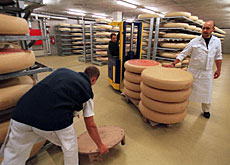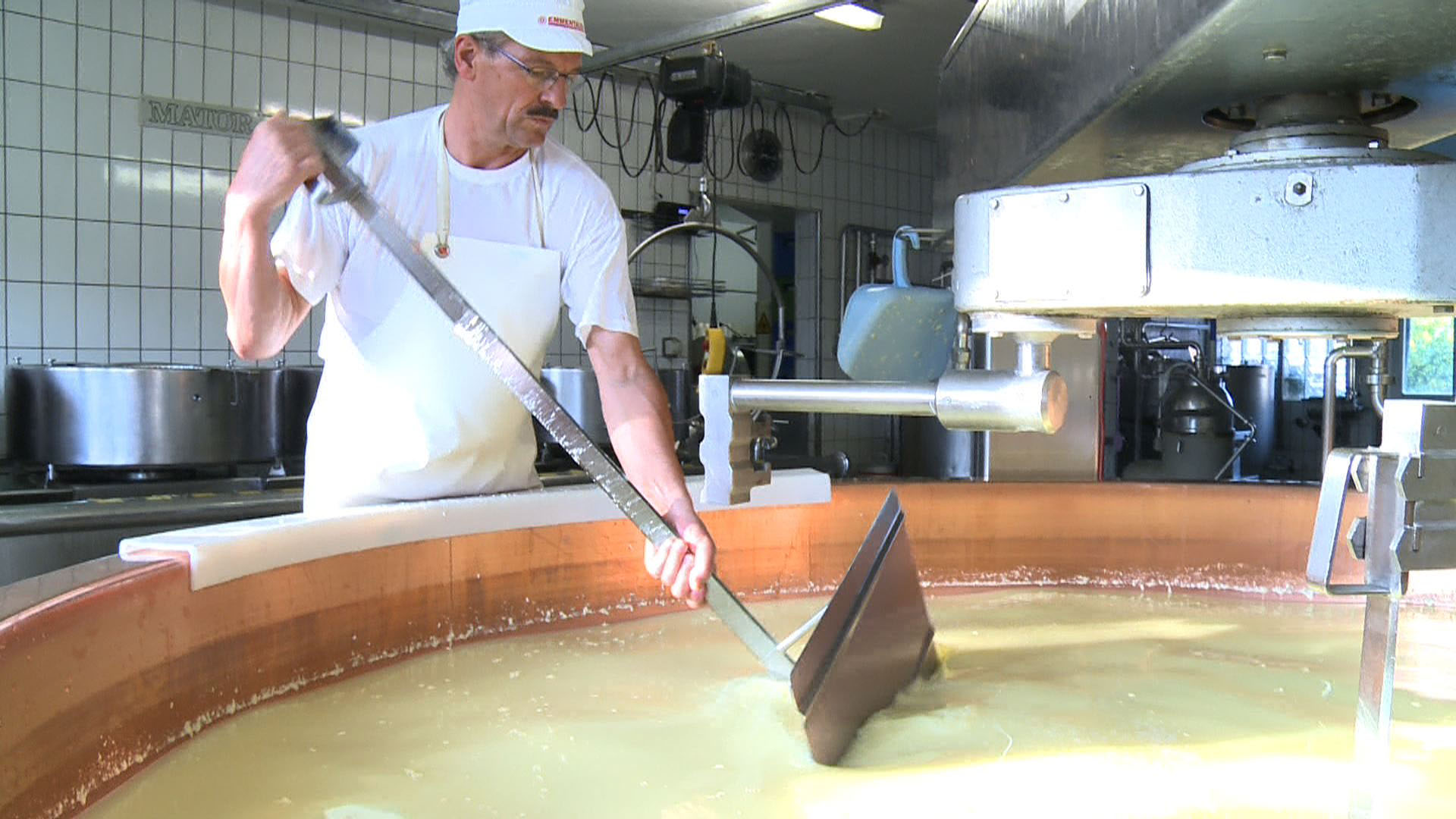Turning around the Emmental cheese industry

Emmentaler cheese is an iconic Swiss export, and yet the branch is battling for its life. The government is considering imposing production quotas across the industry, to help the cheese makers and their milk suppliers stay afloat.
The branch voted to reintroduce quotas this summer after overproduction forced down prices, threatening the survival of the remaining traditional Emmental cheesemaking plants in Switzerland.
The branch umbrella organisation, Emmentaler Switzerland, believes the quota system will only work if it is imposed across the whole industry, and this can only be done with the government’s consent. The economics ministry will complete the consultation process in September, and a decision is expected from the cabinet in October.
Production of this distinctive holey cheese began in the Middle Ages in the picturesque Emmental region of canton Bern. It continues to be made in small family run dairies across German-speaking Switzerland, as well as in large factories. But the cheese makers and dairy farmers are now finding it hard to make ends meet.
The number of dairy farmers involved in the production of Swiss Emmentaler has declined. In 1990, there were 800 Emmental cheese producers in Switzerland. Now there are only 149 producing authentic Emmentaler AOC (Appellation d’Origine Contrôlée).
Emmentaler AOC dealers frequently order more from the cheese makers than they can sell, so the market is flooded and the prices offered by Swiss cheese handlers are often too low.
“One kilo of Emmentaler now costs SFr5.6 per kilo, which is too little to ensure the survival of small dairies,” Emmentaler Switzerland director Franziska Borer told swissinfo.ch.
“Because the cheese producers receive so little, they can’t pay the milk farmers enough to cover their costs. There’s a risk that dairy farmers will deliver their milk elsewhere, or stop producing milk altogether.”
If production is reigned in, she believes the prices will rise, reflecting the true value of the cheese and the milk.
Competition
Another problem for the branch is that the Swiss and international market is swamped with cheaper, mass-produced Emmentaler from highly automated factories in other parts of Europe and the United States.
Such cheese is made from pasteurised milk from cows fed on silage, fermented high moisture plant fodder. Silage produces bacteria in the milk that are not permitted in Swiss AOC cheese.
Swiss AOC cheese does not contain any artificial ingredients. Milk supplied for Emmentaler AOC comes from cows fed on grass and hay only.
The challenge for Emmentaler Switzerland is to make sure consumers are aware of the differences. The organisation pumps about 80 per cent of the compulsory contributions it receives from producers into marketing.
Quality label
The original Swiss Emmentaler was given the quality label AOC in December 2006. The round cheeses weighing 90 to 110 kilograms have the Emmentaler Switzerland label printed clearly on one side.
The cheese makers can also stamp their individual production number on the rounds. These stamps are a guarantee of quality and help to protect the brand from fakes.
Achieving the high standards needed to qualify for the AOC label requires a concerted effort on the part of milk farmers and cheese makers.
Andreas Bernhard is the president of Ursenbach’s cheese association, grouping 18 dairy farmers. They deliver milk to the association’s dairy. swissinfo.ch visited Bernhard on his idyllic farm, where 35 cows munched their way across the rolling green pastures. What’s so different about the local cheese, he was asked?
“It’s all to do with how the cows are kept, what they eat, the environment they live in,” he said. “We have very strict hygiene standards for milking.”
Regular milk probes have to be sent off to a laboratory to test for the presence of bacteria and antibiotics. Milk containing these cannot be sold or used in cheese making.
Ursenbach local cheese dairy is run by Fritz Lehmann and his brother Hans. They produce four cheeses per day, which undergo rigorous controls by the handler after three months of ripening. Last year the Lehmanns won second prize in a national competition organised by Emmentaler Switzerland. Even so, they still face an uncertain future.
Fritz Lehmann believes the handlers should do more to promote the product.
“I think we could sell more Emmentaler AOC if more were invested in promotion,” he said. “It needs more time, more people, more passion. These days the market is flooded with products. You have to be present. You have to insist that your product is the best.”
Stopping overproduction
If production quotas are imposed, Fromarte, the organisation representing the cheese makers, would like to set up a single trading company to handle all orders.
Handlers would be required to order in advance the amounts they intend to sell, and the producers would deliver directly to the company instead of the dealers. This should help stop overproduction and result in a higher price for the cheese.
But Joseph Hardegger, the handler who buys Emmentaler AOC from Ursenbach, does not agree with the idea.
“The problem is that the basic structures of the industry won’t be altered, so there’s no long term guarantee that producers will survive with the new single company and the two year imposition of quotas.”
He fears that the new company will primarily represent the interests of the farmers and producers. “In the short-term, quotas can help to solve the industry’s problems and tackle overproduction. But in the long and medium-term, market forces should bring supply and demand into line.”
Franziska Borer fears that market forces will be left to take their toll if the government does not agree to impose quotas across the board.
The outlook looks gloomy. But in the bigger picture, Emmentaler AOC is still the nation’s most exported cheese.
Exports in 1999: 33,689 tonnes
Exports in 2011: 25,256 tonnes
Number of cheese dairies in 1999: 519
Number of dairies in 2012: 149
Number of dairies closed in 2011: 20
Number of milk producers for Emmentaler: 4,000
Each cheese requires 1200 litres of milk.
This is stirred in a giant vat and heated to over 50 degrees, so that it coagulates and curdles.
It is then poured into round moulds. Any remaining liquid is pressed out.
The AOC stamp is placed on top, and the cheese submerged in a salt bath for a couple of days before going into different storage rooms to ferment and ripen for a minimum of four months.
The size of the holes can be altered by changing the acidity, temperature and curing time of the mixture.
The ‘appellation d’origine contrôlée’ (AOC) is a stamp of quality given to Emmentaler cheese produced under strict conditions by competent specialists in commercial cheese dairies, using a traditional recipe.
The cheese must be produced with fresh raw milk from cows fed only on grass or hay. The milk is not treated and there are no artificial additives.
During the period when subsidies were paid to the branch, there was overproduction of milk. The excess was used to produce Emmentaler cheese, which was exported at rock bottom prices.
In 1999, following agricultural reforms, subsidies to the branch were replaced by direct subsidies to farmers, based on the size of their farms.
Emmentaler Switzerland AOC took over control of the branch from the cheese union and introduced strict rules governing production and sales.
Quotas were introduced in 2005 to curtail over production, but six cheese makers opted out and sold cheaper Emmental under a different label.
The quota system collapsed in 2011 and Emmentaler prices dropped from just over SFr7 per kilo to just over SFr5.

In compliance with the JTI standards
More: SWI swissinfo.ch certified by the Journalism Trust Initiative














You can find an overview of ongoing debates with our journalists here . Please join us!
If you want to start a conversation about a topic raised in this article or want to report factual errors, email us at english@swissinfo.ch.